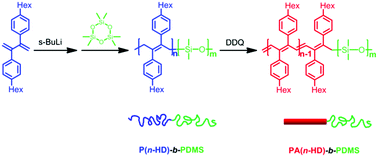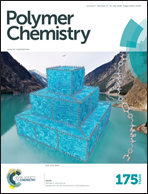Organic–inorganic rod–coil block copolymers comprising substituted polyacetylene and poly(dimethylsiloxane) segments†
Abstract
In this article, we report the synthesis of rod–coil diblock copolymers comprising substituted polyacetylene and poly(dimethylsiloxane) (PDMS) segments through a precursor approach based on living polymerization. The precursor was prepared by sequential anionic vinyl polymerization of a designed template monomer, 2,3-di(n-hexylphenyl)-1,3-butadiene (n-HD), and the anionic ring-opening polymerization of a cyclic monomer, hexamethylcyclotrisiloxane (D3). Block copolymers with well-defined molecular weights were obtained as demonstrated by gel permeation chromatography (GPC), nuclear magnetic resonance (NMR) spectroscopy, and matrix-assisted laser desorption ionization time-of-flight mass spectroscopy (MALDI-TOF MS). The polybutadiene segment of the precursor block copolymer was transformed into a substituted polyacetylene segment, or polyene, by dehydrogenation in the presence of 2,3-dichloro-5,6-dicyano-1,4-benzoquinone (DDQ). The self-assembly behavior of the resulting rod–coil diblock copolymers in dilute solution was investigated by using dynamic light scattering (DLS) and transmission electron microscopy (TEM). It was found that the block copolymers showed a strong tendency to form vesicular aggregates. In some cases intermediate morphologies were observed, such as large size particles and vesicles with loosely packed thick walls. These morphologies developed further into regular vesicles through orientational assembly of the polyacetylene segments, as indicated by the blue shift in UV-Vis and fluorescence spectra.


 Please wait while we load your content...
Please wait while we load your content...